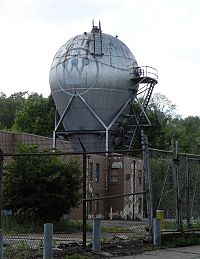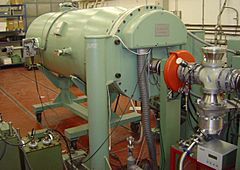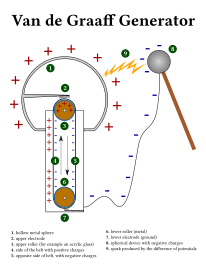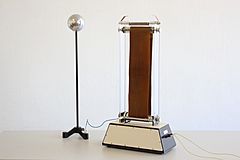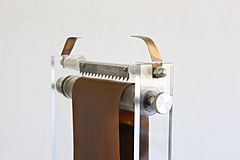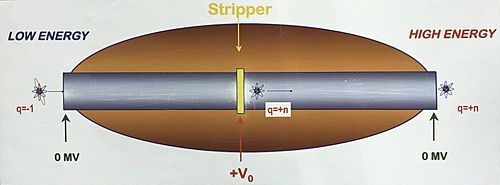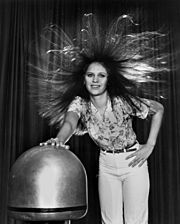Van de Graaff generator facts for kids
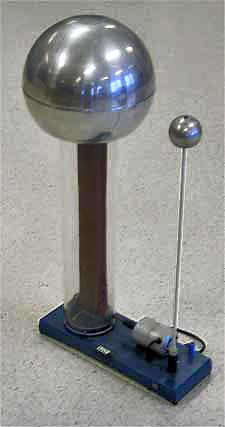
Small Van de Graaff generator used in science education
|
|
| Uses | Accelerating electrons to sterilize food and process materials, accelerating protons for nuclear physics experiments, producing energetic X-ray beams in nuclear medicine, physics education, entertainment |
|---|---|
| Inventor | Robert J. Van de Graaff |
| Related items | linear particle accelerator |
A Van de Graaff generator is a machine that creates static electricity. It uses a moving belt to collect electric charge on a hollow metal ball at the top of a tall, insulated column. This creates a very high electric potential, which is like a strong electrical "push." It makes very high voltage direct current (DC) electricity, but with a low flow of charge. An American scientist named Robert J. Van de Graaff invented it in 1929.
Modern Van de Graaff generators can create a potential difference (voltage) as high as 5 million volts! Smaller ones, like those on a tabletop, can make about 100,000 volts. These smaller machines can store enough energy to make visible electric sparks. You can find small Van de Graaff machines used for fun and to teach about electrostatics (the study of static electricity). Bigger ones are often shown in science museums.
The Van de Graaff generator was first made to be a particle accelerator for science experiments. Its high voltage could speed up tiny subatomic particles inside a special tube. It was the most powerful type of accelerator until the cyclotron was invented in the early 1930s. Today, Van de Graaff generators are still used as accelerators. They create powerful particle and X-ray beams for nuclear research and nuclear medicine.
The voltage an open-air Van de Graaff machine can produce is limited. This is because electricity can jump through the air (called arcing) or leak away (called corona discharge). This limits them to about 5 million volts. Most modern industrial machines are kept in a pressurized tank filled with a special insulating gas. These can reach potentials as high as about 25 million volts.
Contents
History of the Van de Graaff Generator
How the Idea Started
The idea of using a moving part to carry electric charge came from earlier machines. One example is the Kelvin water dropper, invented in 1867 by Lord Kelvin. This machine used falling drops of water to add charge to a bucket. Lord Kelvin himself suggested using a belt instead of water to carry the charge.
The first machine to use an endless belt to move charge was built in 1872 by Augusto Righi. It used a rubber belt with metal rings to carry the charge into a metal sphere. Other inventors also worked on similar belt machines around that time.
Early Development of the Machine
Robert J. Van de Graaff started developing his generator in 1929 at Princeton University. He had help from his colleague Nicholas Burke. The very first model was shown in October 1929. It was made from simple things: an old tin can, a small motor, and a silk ribbon from a store.
After that, he asked for $100 to make a better version. By 1931, he announced that he had reached 1.5 million volts! He said his machine was "simple, inexpensive, and portable." It only needed power from a regular lamp socket. His machine had two large spheres, about 60 cm (2 feet) wide, on tall glass columns. It cost only $90 in 1931.
In 1933, Van de Graaff built a huge 12-meter (40-foot) model at MIT. This giant generator was so big it was kept in an aircraft hangar!
More Powerful Generators
In 1937, the Westinghouse Electric company built a 65-foot (20-meter) machine. This machine, called the Westinghouse Atom Smasher, could make 5 million volts. It was a big step for using nuclear research for peaceful purposes.
A newer type is the tandem Van de Graaff accelerator. This machine has one or more Van de Graaff generators. It speeds up negatively charged ions (atoms with extra electrons) first. Then, inside a high-voltage area, the ions lose some electrons and become positively charged. They are then sped up again. This way, particles get two boosts of speed from one generator!
By the 1970s, these machines could reach 14 million volts. They were placed in tanks filled with high-pressure sulfur hexafluoride (SF6) gas to stop sparks. This allowed them to create powerful beams of heavy ions. The highest voltage ever reached by a Van de Graaff accelerator is 25.5 million volts. This was achieved at the Holifield Radioactive Ion Beam Facility.
Another improvement is the Pelletron. Instead of a rubber belt, it uses a chain of small metal balls connected by insulating links. This chain can move much faster than a belt. This means Pelletrons can reach higher voltages and move more charge. For example, a Pelletron at the Australian National University has chains over 20 meters (65 feet) long that can travel faster than 50 km/h (30 mph)!
The Nuclear Structure Facility (NSF) in the UK was a large tandem Van de Graaff generator. It operated at 20 million volts and was used for many experiments. Scientists used it to study how atomic nuclei are built. One important discovery made with the NSF was about "super-deformed nuclei." These nuclei spin very fast when they form.
How a Van de Graaff Generator Works
A simple Van de Graaff generator has a rubber belt that moves over two rollers made of different materials. One roller is inside a hollow metal sphere at the top. There are also two comb-shaped metal pieces with sharp points. The top comb (2 in the diagram) is connected to the sphere. The bottom comb (7) is connected to the ground.
When a motor moves the belt, something cool happens! Because the belt and rollers are made of different materials, they rub together. This causes electrons to move from one material to another. This is called the triboelectric effect, and it's how you get static electricity when you rub a balloon on your hair!
In our example, the rubber belt becomes negatively charged. The top roller, often made of acrylic glass, becomes positively charged. The belt then carries the negative charge upwards on its inside surface.
Next, the strong electric field around the positive top roller (3) makes a very strong electric field near the points of the top comb (2). This field is so strong that it makes the air molecules around the comb lose electrons. These electrons are attracted to the outside of the belt. The positive parts of the air molecules go to the comb. At the comb, they pick up electrons from the metal. This leaves the comb and the metal sphere (1) with fewer electrons, giving them a positive charge.
Because of a rule called Gauss's law, any extra positive charge collects on the outside surface of the sphere. There is no electric field inside the sphere. As the belt keeps moving, it continuously brings more charge to the sphere. The charge keeps building up until the amount of charge leaving the sphere (through leaks or sparks) equals the amount of new charge coming in.

The bigger the sphere, and the farther it is from the ground, the higher the voltage it can reach. You can even control whether the sphere gets a positive or negative charge by choosing different materials for the belt and rollers.
The Van de Graaff generator's top part doesn't have to be a perfect sphere, but a rounded shape is best. A rounded shape helps prevent the electricity from leaking into the air. Since a Van de Graaff generator can provide a small, steady flow of electricity at almost any voltage, it's like an ideal current source.
The maximum voltage a generator can reach depends on the size of the sphere and how easily electricity can jump through the air around it. For air, electricity starts to jump at about 30,000 volts per centimeter. So, a polished sphere 30 cm (about 1 foot) across could reach about 450,000 volts. This is why Van de Graaff generators often have very large spheres!
Using Van de Graaff Generators as Particle Accelerators
Scientists first built Van de Graaff generators to create high voltages. They used these voltages to speed up particles for experiments in nuclear physics. The huge voltage difference between the sphere and the ground creates a strong electric field. If a source of ions (charged atoms) is placed near the sphere, this field will push or pull the charged particles away from the sphere, making them go very fast. By putting the generator in a tank with pressurized gas, the voltage can be even higher, making the particles go even faster.
Tandem Accelerators
Many Van de Graaff particle accelerators are set up in a "tandem" way. In this setup, the high-voltage part is in the middle of the machine. Negatively charged ions are shot in from one end. They are pulled towards the high-voltage center. When they reach the center, they pass through a thin material that strips away some of their electrons, making them positively charged. Then, they are pushed away from the high-voltage center and speed up even more! This design lets particles get two boosts of speed from just one Van de Graaff generator. It also makes it easier to work with the ion source, which stays near the ground.
Pelletron Accelerators
The Pelletron is a special type of tandem accelerator. It solves some problems that traditional belt-driven Van de Graaff generators have. Instead of a rubber belt, the Pelletron uses a chain of small metal balls, or "pellets," connected by insulating links. This chain of pellets does the same job as the belt: it carries charge to the high-voltage part. Because the chain is made of separate charged balls and is very strong, it can operate at much higher speeds. This means Pelletrons can reach higher voltages and move charge faster than regular Van de Graaff generators.
Fun and Educational Generators
The biggest air-insulated Van de Graaff generator in the world is at the Museum of Science in Boston. Dr. Van de Graaff himself built it in the 1930s. It has two huge aluminum spheres, each 4.5 meters (15 feet) wide, on columns 22 feet (6.7 meters) tall. This giant machine can often reach 2 million volts! The museum puts on shows with it, creating "lightning" and making people's hair stand on end.
Many science museums, like the American Museum of Science and Energy, have smaller Van de Graaff generators. They use them to show how static electricity works. They can make sparks or make people's hair stand up straight, which is always a fun sight! Van de Graaff generators are also popular in schools and science shows to teach about electricity.
How it Compares to Other Static Machines
Other electrostatic machines, like the Wimshurst machine, also move charge to create high voltage. But the Van de Graaff generator is special because it can make the highest voltages. This is because its design, with the charge being carried inside a large, smooth, hollow sphere, helps to stop electricity from leaking away. The bigger and smoother the sphere, the higher the voltage it can reach. This is why the Van de Graaff design has been used for all electrostatic particle accelerators.
See also
 In Spanish: Generador de Van de Graaff para niños
In Spanish: Generador de Van de Graaff para niños
- Electrostatic levitation
- Faraday cage
- Metal spinning
- Oudin coil
- Tesla coil


